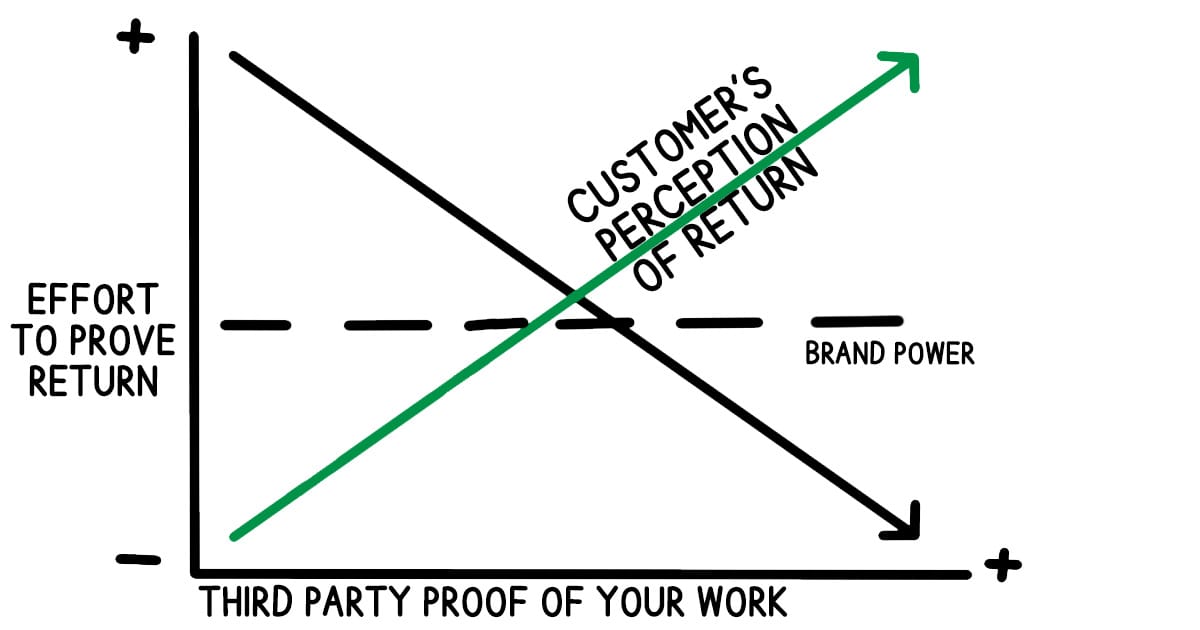Quick notes to help you grow your business in less time with less effort. . . starting next week.
In this issue:
- Thoughts on ROI
- Being Human
- Random Stuff
Thoughts on ROI
- The highest human ROI activity I've encountered is volunteering. A regular one hour commitment easily returns 10 hours of contentment.
- Zero effort equals zero results, over time. Easy ROI to calculate. You'd think that means 100% effort gives you 100% results over time, but that's not quite right. It gives 100% of a chance for some kind of results.
- How much time is invested in examining your company's internal database? I find a solid ROI profiling a client's best customers, then applying that profile to the 80% of the database that isn't "best." This shows us a number of lookalikes that aren't behaving like best customers. Talk to them first.
- Seeing news reports of giant piles of money being invested in an industry or niche is a good reminder not to confuse dollars with idea validation.
Being Human – Branding ROI
"When people are free to do as they please, they usually imitate one another."
– Eric Hoffer

A favorite decision making calculation is ROI, short for Return On Investment. As with all heuristics, it's not perfect, and it's not meant to be the only consideration in making a decision, but it's useful.
Starting at the end of the equation, the Investment in ROI is pretty simple. It's the cost in money, time, and manpower to implement something. For instance, if we have a project for lead generation, the Investment can be expressed as the number of per hour charges needed to complete it, the timeframe it gets completed in, and the number of people put into planning/managing the project. Add it all up and that's the Investment.
The Return in the ROI is harder to measure. It's the accounting of what we get from all that money, time, and manpower. When deciding on a solution, our prospects have started thinking about the value of their people's time, the value of a new customer, or what it's worth gaining entry into a new market. I have a profound thought about this after years of experience: they are either guessing at the value of the Return or they have evidence guiding their decision.
Sometimes getting agreement on the Return value/number is a point of conflict. My other profound thought: the most important Return number comes from the client, not the seller. An easy way to think of this is to look at neighbor's young son. One person on the block thinks asking the young man to mow his lawn is a way to invest in the future, teaching some lessons about hard work. Plus it buys the old man some extra time in their week. Another neighbor sees the same kid and thinks, no way I'm paying for that. He's too expensive, I can do it better myself. The young man, on the other hand, might think, I have nothing better to do for an hour and I get $30! Each person calculates a rough ROI in their mind and acts on it. The most important one for the young man is the opinion of the one doing the hiring!
ROI calculations aren't static things. They change over time. When we start work with a client they don't always know what's going to happen. We can help them with that. The best way for us to help is for them to hear about us from other customers. People just like them. The more of that evidence you can provide, the easier it is for the client to make the ROI work.

On the X axis is the amount of third party evidence you can provide on the ROI of your work. On the Y axis, we see the effort salespeople have to expend explaining/selling, high to low. Through the middle, the dashed line represents the firm's brand power. The more your customers tell prospects about how great the firm is, not only do your people spend less time explaining ROI, but customer's begin to find more reasons why it works.
Social proof. Brand power.
Random Stuff
"If Mozart had power tools, there's no telling how great his music might have been." – Dave Barry

As I'm leaving the coffee shop, I have to make a pit stop at the busing station to drop a dish. The station is next to a group of three young women who look to be college age. They are all looking at laptops and talking. My back is to them as I work through which trash and which dish goes where.
"It's this," said the first one.
"Wait, how did you get that?" said the second.
"ChatGPT said it," said the first, laughing.
"How did it get it, though?" said the second.
I would have loved to hang around to see where the conversation went, but I didn't want to be called a creepy old man, so I kept 'er movin'.
The question is a great one. How do we know? The things I know best are from trying A+B and getting C, then one day trying A+B and getting D. Thinking through the change in results is where my best learning happens.
For instance, workshop safety. The soon-to-be-parents of our first grandchild asked me if I had a Dremel cutting tool. I do. They found the perfect knobs for baby's nursery dresser, but the bolts are too long. I know this problem. It's one of the reasons I own a Dremel cutting tool which rotates at 5,000-35,000 RPM. It's also why I have a little vice that attaches to the workbench. Hard things get squirrelly when hit by thousands of RPMs. Back to bolt cutting. . .one bitter cold winter day I needed to cut down a series of knob bolts. Having owned the tool for a decade, I know just what to do. Piece of cake.
My process is roughly measure twice, cut once, use a metal file to take off the rough edges, don't lose track of the piece you just cut off, be careful because the bolt is hot, and don't go barefoot around the workbench.
There's on more thing. Wear safety glasses. I already wear glasses, but safety glasses are a necessity. On this cold day, for most of the morning A+B= C. I measure, cut, file, and find. Then something new happened. The blade on the Dremel broke. It whizzes by my face, nicking my glasses frames, then flies out into the wilderness that is my garage. Not a near death experience, but it left a mark.
I mean, even ChatGPT knows to wear safety glasses when using a Dremel. It's the first thing after "get a Dremel" and "attach a cutting disc."
How does it know, though?





